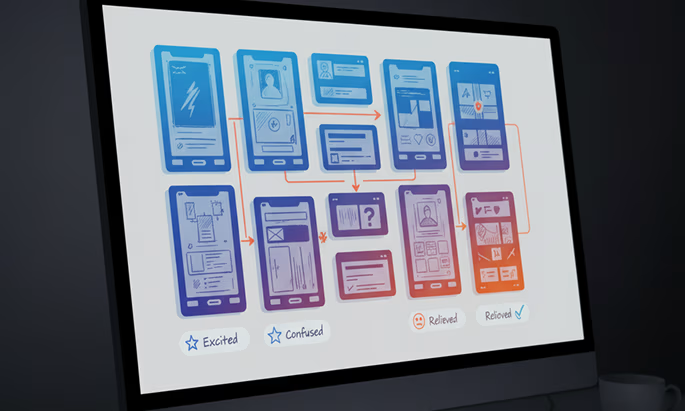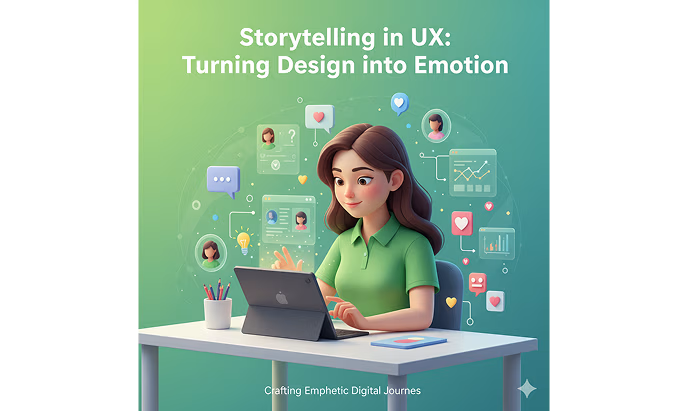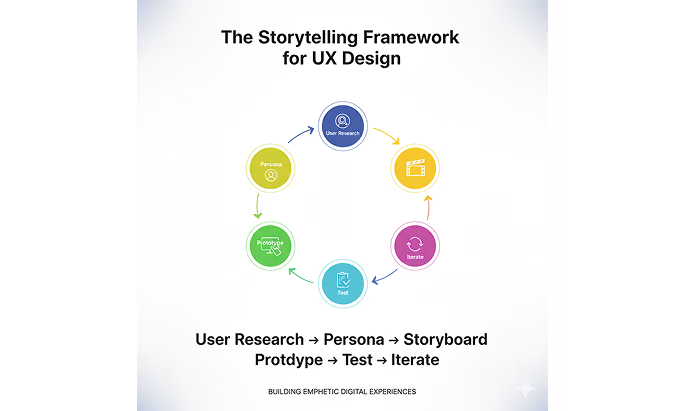Table of Contents
- Why Storytelling Matters in UX Design
- The Role of User Research in Crafting UX Stories
- Elements of a Compelling UX Story
- Storyboarding for UX
- Interactive Storytelling in Digital Products
- Common Mistakes in UX Storytelling (and How to Avoid Them)
- Measuring the Impact of Storytelling in UX
- Conclusion: Why Every UX Designer Should Embrace Storytelling

In today’s digital landscape, users interact with countless apps, websites, and platforms every day. Yet, only a few experiences leave a lasting impression. What sets them apart? The answer is storytelling. Storytelling in UX design transforms a product from a set of screens and buttons into an experience that feels human, relatable, and emotionally engaging.
By embedding narrative into the design process, designers guide users, communicate brand values, and make interactions intuitive. For product teams, mastering storytelling isn’t just about aesthetics—it’s about creating products that resonate, retain, and delight users.
Why Storytelling Matters in UX Design

Humans are wired for stories. Neuroscience research shows that narratives activate emotions and memory, making users more likely to engage with and remember a product. In UX design, storytelling helps translate complex features into relatable experiences. Instead of presenting users with a dashboard full of metrics, a well-told story guides them through their journey, highlighting what matters most and making actions feel meaningful.
For instance, a budgeting app that narrates a user’s financial progress with clear milestones and feedback feels more motivating than a static chart. Storytelling helps create trust and empathy, which are crucial in fields like FinTech, healthcare, or educational apps.
Storytelling vs Traditional UX Methods
Traditional UX methods focus on functionality, efficiency, and usability, which are essential but often sterile. Storytelling introduces context, emotion, and purpose. It transforms a user journey from a series of clicks into a meaningful narrative.
A traditional onboarding flow might simply explain how features work, whereas a narrative-driven flow might show a user “overcoming financial challenges” through the app, turning abstract steps into a personal story. The combination of usability and narrative ensures both efficiency and emotional resonance.
The Role of User Research in Crafting UX Stories
No story works without understanding its audience. User research provides the insight needed to craft compelling narratives. Personas, surveys, interviews, and behavioral analytics uncover users’ goals, pain points, and motivations.
For example, research might reveal that new users feel intimidated by financial apps. A storytelling approach would craft onboarding sequences that gently guide users through tasks, celebrate small achievements, and make the journey feel safe and encouraging. Without this research, the story risks being generic, ineffective, or disconnected from real user needs.
Mapping the User Journey Through Storytelling

Storytelling in UX begins with mapping the user journey. Every touchpoint, decision, and interaction becomes a plot point in the narrative. Designers can use journey maps to visualize emotions, challenges, and moments of delight across the user experience.
A travel app, for example, could structure its journey as a story: discovery, planning, booking, and adventure. Each step is designed to evoke anticipation, confidence, and satisfaction, turning a transactional process into a memorable experience.
Elements of a Compelling UX Story
A strong UX story has the same structural elements as any good narrative: a relatable character, a challenge, and a resolution. In UX design, the user is the protagonist, their pain points are the conflict, and the product’s features provide solutions.
The narrative also includes pacing, context, and emotional cues. Consider a meditation app: the user struggles with stress (conflict), the app provides guided sessions (resolution), and subtle visual and auditory cues enhance relaxation (emotion). This storytelling approach ensures that the experience feels cohesive, human, and engaging.
Emotional Design and Storytelling in UX
Emotions drive decisions. Storytelling amplifies emotional design by aligning interface elements with the narrative. Colors, typography, animations, and micro-interactions can reinforce feelings of trust, urgency, delight, or comfort.
For instance, a FinTech dashboard can use green progress bars for savings achievements, celebratory animations for milestones, and warm tones to reduce stress when displaying financial information. By linking narrative and design elements, users feel connected, motivated, and guided throughout the experience.
Storyboarding for UX
Storyboarding is a practical method for visualizing UX narratives. Designers sketch sequences of screens, highlighting user interactions, decisions, and emotional responses. These storyboards act as a blueprint for both the design and development teams.
Using storyboards, a UI/UX design agency can preempt user friction points, align stakeholders, and iterate faster. Storyboarding also enables teams to explore multiple narrative approaches before investing in high-fidelity designs or prototypes, saving both time and resources.
Microcopy and UX Writing as Storytelling Tools

Words matter in UX. Microcopy—such as button labels, tooltips, notifications, and onboarding instructions—can reinforce the story. Clear, empathetic language guides users through the experience, explains functionality, and maintains narrative continuity.
For example, instead of a generic “Submit” button, a savings app might use “Secure My Goal,” reinforcing the user’s journey and providing emotional context. UX writing paired with visual storytelling ensures that even subtle interactions support the overall narrative.
Interactive Storytelling in Digital Products

Digital products allow for interactive storytelling, where users engage with the narrative rather than passively consuming it. Interactive elements like gamified progress, personalized recommendations, and responsive feedback loops make users feel part of the story.
A fitness app, for instance, could present achievements as “levels completed” and challenges as “missions,” turning goal-tracking into a narrative adventure. Interactive storytelling not only engages users but also encourages retention, referral, and long-term loyalty.
Case Studies: Storytelling in Successful UX Designs
Several products exemplify how storytelling transforms UX. Take a FinTech app designed with a UI/UX agency partnership: instead of showing raw investment data, the app narrates the user’s financial journey, highlights milestones, and offers contextual advice at each step. The result is increased adoption, higher engagement, and more satisfied users.
Similarly, onboarding flows in apps like Duolingo or Headspace guide users through stories of progress and achievement, making learning and habit-building feel personal and rewarding. These cases demonstrate the tangible benefits of integrating storytelling into UX.
Common Mistakes in UX Storytelling (and How to Avoid Them)
Even the best intentions can backfire if storytelling is misapplied. Common mistakes include overcomplicating the narrative, ignoring usability, or prioritizing aesthetics over functionality. A story that feels forced or unrelated to user needs can confuse or frustrate users.
The solution is to align narrative with real user insights, keep interactions intuitive, and maintain consistency across screens. By integrating storyboarding, user research, and microcopy, designers can avoid these pitfalls and create authentic, impactful experiences.
Actionable Steps to Integrate Storytelling in UX Design

Start by conducting thorough user research to understand goals, pain points, and emotional triggers. Map the user journey, identifying moments that can be enhanced with narrative elements. Create storyboards to visualize the flow, then design wireframes and high-fidelity prototypes that incorporate visual and interactive storytelling.
Test the experience with real users, gather feedback, and refine the story continuously. Collaborating with a UI/UX design agency can accelerate this process, bringing professional expertise in both narrative strategy and interface design.
Measuring the Impact of Storytelling in UX
Storytelling’s impact can be measured through both quantitative and qualitative metrics. Track engagement rates, conversion, retention, and task completion, and gather user feedback on clarity, satisfaction, and emotional resonance.
Analyzing these metrics allows teams to understand which narrative elements work, which need improvement, and how storytelling contributes to overall business goals. Continuous testing ensures that the story evolves with user needs and market trends.
The Future of Storytelling in UX
The future of UX storytelling is increasingly interactive and personalized. AI can adapt narratives based on user behavior, while AR/VR offers immersive experiences that make digital stories feel tangible. Personalization ensures that each user experiences a unique narrative journey, increasing relevance and engagement.
Designers who embrace these innovations will create products that not only meet functional needs but also connect emotionally, leaving a lasting impact in competitive digital landscapes.
Conclusion: Why Every UX Designer Should Embrace Storytelling
Storytelling is no longer an optional design flourish—it’s a fundamental strategy for creating meaningful, engaging, and memorable digital experiences. By understanding user goals, mapping journeys, crafting narratives, and leveraging UI/UX expertise, designers can transform functional interfaces into experiences that resonate.
From onboarding flows to complex dashboards, narrative design improves engagement, retention, and satisfaction. For startups, agencies, and product teams, mastering storytelling in UX is the key to standing out and building products that users love.
FAQs
1. What is storytelling in UX design?
Storytelling in UX design is the practice of using narrative techniques to guide users through a digital product. It creates engaging, meaningful experiences by connecting design, functionality, and user emotions.
2. Why is storytelling important for UX designers?
Storytelling improves usability, engagement, and retention by giving context to user actions. It helps users understand the product, builds trust, and makes interactions more memorable.
3. How can I integrate storytelling into UX design?
Start with user research to understand goals and pain points. Map the user journey as a narrative, create storyboards, design wireframes and prototypes, and test interactions. Microcopy, visual hierarchy, and interactive elements reinforce the story.
4. What are common mistakes in UX storytelling?
Common errors include overcomplicating the story, forcing narratives that don’t align with user needs, ignoring usability, and neglecting consistent messaging. Storytelling should complement functionality, not overshadow it.
5. Can storytelling improve the success of digital products?
Yes. Products designed with narrative principles show higher engagement, better user satisfaction, and increased retention. Storytelling helps users relate to features, understand processes, and stay loyal to the brand.
Fresh UI/UX Ideas, Straight to Your Inbox





